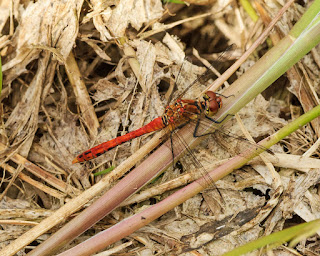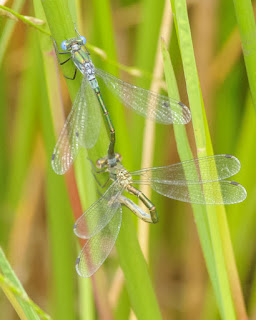We had a lot of fun in Stevenage Thursday night/Friday morning with a fairly short thunderstorm and heavy rain. I had a lie in as usual and the local radio was reporting serious flooding in the Roebuck area and elsewhere with a van stuck under the railway bridge on Old Knebworth Lane. Judging by some of the containers in the garden we had about an inch of rain and it did not seem to be all that bad driving into work, with just a few puddles and standing water in some of the underpasses, so it did seem to be rather localised and some areas got off lightly. Having got into work quite late I missed the mopping up operation-apparently water was bubbling up from under the floor (well Stevenage is built on springs) and rain had brought down part of the ceiling in one of the areas round the back. Heard that the van was removed from the bridge around noon, and less than an hour later some dick in another van ignored the warning signs and guess what happened next.
Saturday morning was spent at Amwell. Its been a few weeks since I have been down and I was not expecting much. Apparently there is a Black Bellied whistling Duck around-its rather quiet otherwise with moulting ducks some Lapwings and a few juvenile gulls around. William was the only one present when I got there and we spent most of the morning bug hunting.
According to Barry Small Red Eyed Damselflies are on Tumbling Bay, but we only managed to locate a couple of Red yes, Common Blues and Blue Tails. The only large dragonfly was a Black Tailed Skimmer though on our return we saw a number of Emperors. The Norfolk Hawker has not been reported for a few days now but may still be around though its getting a bit late for them. The Hollycross area was full of blue damselflies in the grass, with a couple of Emperors and Brown Hawkers. Meadow Browns and Skippers were abundant with reasonable numbers of all three whites, a Marbled White and my first Small Copper of the year. We had a quick search for Scarce Chaser and Willow Emeralds but I suspect we are too late for the former and too early for the latter.
Today I went for a walk around Aston End and along the Beane. We had some light rain overnight and it was a bit windy at times but it eventually warmed up and butterflies came out.
Rather pleased with the number of Greenfinches, Yellowhammers and Linnets seen and heard as they do seem to be increasing. However there was no sign of any Corn Buntings-last years birds presumably a one off.
Huge numbers of Large Whites everywhere, and Meadow Browns were just about as abundant as were Skippers once I had reached some Thistle patches. Smaller numbers but still several tens of Small Whites, Green Veined Whites and Gatekeepers, with ten plus Comma, Small Tortoiseshell and Ringlets. Two Marbled Whites were a bit of a disappointment as was the one Common Blue but two Brown Argus was a bonus-another species I have hardly seen this year. The wind made photography a bit of a gamble and mostly it was landscapes but I got a couple of butterflies.
Sunday, 19 July 2015
Saturday, 11 July 2015
Hertford Heath Emeralds
One of the things I had intended to do yesterday was visit Hertford Heath, as a number of Scarce Emerald Damselflies had been present-Hertfordshire's first since the late 50's. As Colin wasn't to bothered about a long trip out today he popped over and took me down.
Even at 0900 it was getting rather hot and it was not long before butterflies and dragonflies were being seen. We found a small marshy pool on the west side that still held some water, and we spent a bit of time here. Ruddy Darters seemed to be the most abundant species here, outnumbering the Common Darters with lots of Azure Damsels, a few Large Reds, one Blue Tail, two Emperors and a Black Tailed Skimmer. i and a bit of a problem with the Emeralds Damselflies here, with two or three males seen and a brief view of a large robust female. Colin's best photo showed an Emerald Damselfly, but the few decent shots I got here were of a Scarce Emerald.
Few birds noted, as it is a quiet time of year but a Nuthatch was vocal and six Siskins flew over.
W carried on into Balls Wood targeting butterflies. We already had large numbers of Large and Small Skippers (only checked a few to confirm Essex Skippers), Ringlets, Meadow Browns, some Large Small and Green Veined Whites, Commas, Small Tortoiseshells and a single Holly Blue. A walk around the northern part of the wood produced more of the same, plus one Purple Hairstreak, a few Silver Washed Fritillaries and two White Admirals.
We returned to the heath and spent some time on the old brick ponds. These seemed to be the Emerald stronghold as they were everywhere. Here there were plenty of Emeralds and one pair of Scarce Emeralds posed for us. I cannot say for certain how many Scarce Emeralds were on the reserve but six males and three females is a conservative minimum.
Even at 0900 it was getting rather hot and it was not long before butterflies and dragonflies were being seen. We found a small marshy pool on the west side that still held some water, and we spent a bit of time here. Ruddy Darters seemed to be the most abundant species here, outnumbering the Common Darters with lots of Azure Damsels, a few Large Reds, one Blue Tail, two Emperors and a Black Tailed Skimmer. i and a bit of a problem with the Emeralds Damselflies here, with two or three males seen and a brief view of a large robust female. Colin's best photo showed an Emerald Damselfly, but the few decent shots I got here were of a Scarce Emerald.
Few birds noted, as it is a quiet time of year but a Nuthatch was vocal and six Siskins flew over.
W carried on into Balls Wood targeting butterflies. We already had large numbers of Large and Small Skippers (only checked a few to confirm Essex Skippers), Ringlets, Meadow Browns, some Large Small and Green Veined Whites, Commas, Small Tortoiseshells and a single Holly Blue. A walk around the northern part of the wood produced more of the same, plus one Purple Hairstreak, a few Silver Washed Fritillaries and two White Admirals.
We returned to the heath and spent some time on the old brick ponds. These seemed to be the Emerald stronghold as they were everywhere. Here there were plenty of Emeralds and one pair of Scarce Emeralds posed for us. I cannot say for certain how many Scarce Emeralds were on the reserve but six males and three females is a conservative minimum.
Friday, 10 July 2015
Friday Off
Took the day off today. Had lots of plans with visits to several sites, but woke up with a headache and a bad stomach so just went out for a couple of hours.
As seems to be usual these days, Harriers have been reported between Baldock and Royston intermittently this Summer. One eventually got pinned down-a ringtail Montagues near wallington at the old Quail site and has appeared on and off in the area all week. To add to the fun, a male Hen Harrier has been seen on a couple of occasions. Neither has been seen since Wednesday, but in this vast area birds have a habit of vanishing for long periods.
I got there just after 0900, with only a couple of dog walkers for company, but eventually Tony Wileman, one of the Tring birders and a few others appeared (one had spent eight hours earlier in the week without a view). Probably half a dozen Corn Buntings were singing as I arrived, along with large numbers of Skylarks, and on the way up I had encountered lots of Linnets and Yellowhammers as well, so small birds seem to be doing well up here.
First decent sighting was the Battle of Britain flight heading down to London-five Spitfires and a Hurricane flew over around 0930. Next decent sighting, and a bit of an odd one were two Sand Martins heading west.
I stuck it out until noon, as did Tony, but although we had plenty of Red Kites, Buzzards and Kestrels there were not sign of any other birds of prey, however in the heat haze anything more than half a mile away would be largely unidentifiable blobs. The guy who had the eight hour wait had been round the other usual spots-Deadmans Hill, Coombe Road etc and had not seen anything of note.
Be interesting to see if any further repots crop up from the regulars, or if the birds get refound, perhaps at Therfield or maybe the Ashwell area -lots of good habitat to lose a harrier in in the remoter parts of Herts and neighbouring counties.
As seems to be usual these days, Harriers have been reported between Baldock and Royston intermittently this Summer. One eventually got pinned down-a ringtail Montagues near wallington at the old Quail site and has appeared on and off in the area all week. To add to the fun, a male Hen Harrier has been seen on a couple of occasions. Neither has been seen since Wednesday, but in this vast area birds have a habit of vanishing for long periods.
I got there just after 0900, with only a couple of dog walkers for company, but eventually Tony Wileman, one of the Tring birders and a few others appeared (one had spent eight hours earlier in the week without a view). Probably half a dozen Corn Buntings were singing as I arrived, along with large numbers of Skylarks, and on the way up I had encountered lots of Linnets and Yellowhammers as well, so small birds seem to be doing well up here.
First decent sighting was the Battle of Britain flight heading down to London-five Spitfires and a Hurricane flew over around 0930. Next decent sighting, and a bit of an odd one were two Sand Martins heading west.
I stuck it out until noon, as did Tony, but although we had plenty of Red Kites, Buzzards and Kestrels there were not sign of any other birds of prey, however in the heat haze anything more than half a mile away would be largely unidentifiable blobs. The guy who had the eight hour wait had been round the other usual spots-Deadmans Hill, Coombe Road etc and had not seen anything of note.
Be interesting to see if any further repots crop up from the regulars, or if the birds get refound, perhaps at Therfield or maybe the Ashwell area -lots of good habitat to lose a harrier in in the remoter parts of Herts and neighbouring counties.
Subscribe to:
Comments (Atom)









